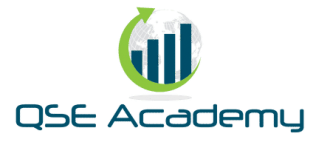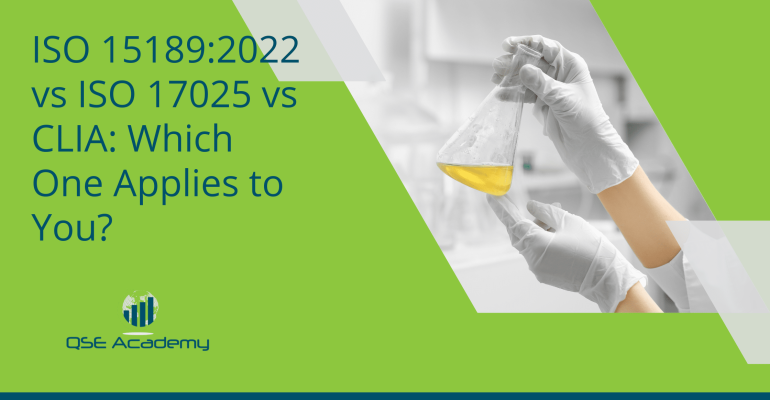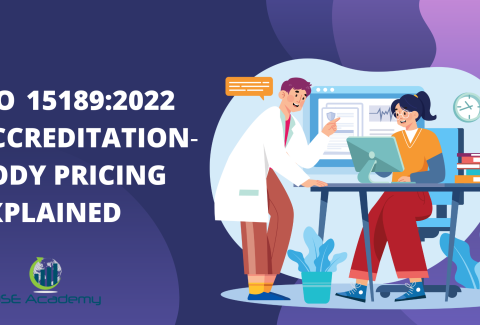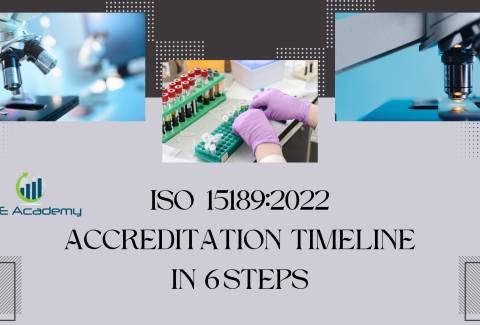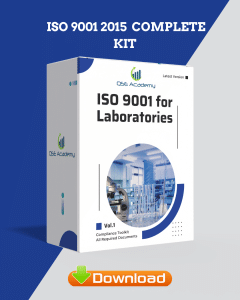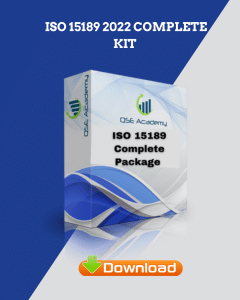ISO 15189:2022 vs ISO 17025 vs CLIA: Which One Applies to You?
Last Updated on October 22, 2025 by Hafsa J.
ISO 15189:2022 vs ISO 17025 vs CLIA: Which One Applies to You?
Let’s be honest—most labs don’t wake up thinking, “Today’s the day I figure out my accreditation pathway.” What usually happens is someone—maybe a client, an auditor, or a regulator—asks a tough question like, “Are you CLIA certified?” or “Is your lab ISO accredited?”
And suddenly, you’re scrambling to figure out what applies to your setup.
In my experience, this confusion happens all the time. I’ve worked with clinical labs, calibration labs, startup diagnostics companies—you name it. And what I’ve noticed is this: many of them are following the wrong standard or trying to fit into one that doesn’t really match their services.
Here’s the thing: ISO 15189, ISO/IEC 17025, and CLIA all have different purposes. They serve different types of labs, they come with different expectations, and in some cases, one is legally required while the other is voluntary—but still incredibly valuable.
In this article, we’re going to break it all down. No fluff. No jargon overload. You’ll walk away knowing:
-
What each standard or regulation is really about.
-
Which one fits your lab based on what you test and who you serve.
-
Whether you might actually need more than one.
So if you’ve been unsure where your lab fits—or you’re starting something new and want to get it right from day one—this guide’s for you.
Let’s clear it up once and for all.
What Is ISO 15189:2022?
If your lab is involved in diagnosing patients—processing blood work, running PCR tests, reporting critical values—ISO 15189 is your standard. Plain and simple.
It was built specifically for medical laboratories, and the 2022 version raises the bar even further by focusing on things like patient safety, clinical relevance, and risk-based decision-making.
Here’s what I’ve noticed…
A lot of labs try to adapt ISO 9001 or ISO 17025 to cover clinical testing. And while those standards are great in the right context, they don’t fully address things like critical result reporting, physician communication, or the traceability that comes with patient care.
ISO 15189 does.
It’s built for environments where a testing error could directly affect someone’s diagnosis or treatment—and that changes everything.
What makes ISO 15189 different?
-
It’s patient-focused, not just process-focused.
-
It requires clinical communication protocols, not just analytical accuracy.
-
It includes oversight for Point-of-Care Testing (POCT), which is now part of many modern lab networks.
Real-world example:
I worked with a private diagnostics lab that handled everything from routine bloodwork to COVID PCRs. They’d been ISO 17025 certified but kept running into issues with physician trust and hospital integration. Once they transitioned to ISO 15189, they could finally meet clinical expectations—and it opened doors to hospital contracts and regional health partnerships.
What Is ISO/IEC 17025?
Now, if your lab isn’t directly involved in diagnosing patients—but you’re testing materials, calibrating instruments, or generating scientific data—ISO/IEC 17025 is likely your match.
This standard is designed for testing and calibration laboratories, not medical diagnostics. Think food safety labs, environmental testing, pharma QC, material analysis, even forensic and industrial labs.
Here’s what I’ve noticed…
A lot of non-clinical labs get pushed toward ISO 15189 just because they’re in a healthcare-adjacent space. But if you’re not producing results that go into a patient’s chart, then ISO 17025 is probably the better (and simpler) fit.
It focuses on technical competence, measurement traceability, and producing valid, repeatable results—without diving into clinical care systems or patient communication requirements.
Key differences from ISO 15189:
-
It’s built around scientific and technical measurements, not medical risk.
-
No clinical pathways or physician communication required.
-
It applies to a huge variety of industries: agriculture, manufacturing, construction, energy, and more.
A client story that brings it home:
I worked with a lab that did drug residue testing for food exports. They were convinced they needed ISO 15189 because their results were “health-related.” But once we mapped out their actual workflow, it was clear—they weren’t diagnosing anyone. ISO 17025 was a perfect fit. We focused on method validation, proficiency testing, and equipment calibration—and they passed their audit on the first try.
What Is CLIA? (U.S.-Based Clinical Lab Regulation)
If you’re operating in the United States and performing any kind of testing on human specimens for diagnosis, prevention, or treatment—then you’re probably already dealing with CLIA.
CLIA stands for the Clinical Laboratory Improvement Amendments, and unlike ISO standards, this one’s not optional. It’s a federal requirement. Without it, you legally can’t run human diagnostic tests in the U.S.—period.
Let’s be real…
I’ve worked with labs that spent months preparing for ISO 15189 or ISO 17025, only to realize they’d skipped the most important step: getting their CLIA certificate.
ISO builds trust. CLIA keeps you legal. You need both if you’re in the U.S. and want to operate smoothly.
What makes CLIA different?
-
It’s regulatory, not voluntary.
-
Issued by CMS (Centers for Medicare & Medicaid Services).
-
Based on test complexity—not lab type.
-
Every lab gets assigned a certificate type (e.g., Waived, Moderate, High Complexity).
-
Requires regular inspections and proficiency testing.
A real-world situation:
I once helped a small clinic in Texas that had just bought a rapid molecular testing system. They were ready to launch… until someone asked about their CLIA certification. They didn’t have one. We paused the project, got them registered, and built out their compliance system from the ground up. A few months later, they were not only compliant—they had a scalable setup that could expand into new locations.
ISO 15189 vs ISO 17025 vs CLIA: A Side-by-Side Comparison
By now, you’re probably thinking, “Okay, I get the gist—but how do I really know which one fits my lab?”
Let’s simplify it.
Here’s a quick comparison table I often walk through with clients when we’re mapping out their accreditation path. It lays out the essentials—so you can see at a glance what each framework is really for.
At-a-Glance Comparison Table
| Standard/Regulation | Who It’s For | Mandatory or Voluntary | Where It Applies | Primary Focus |
|---|---|---|---|---|
| ISO 15189:2022 | Medical/clinical labs | Voluntary (but often expected) | Global | Patient safety, diagnostic quality, clinical risk |
| ISO/IEC 17025 | Testing & calibration labs (non-clinical) | Voluntary | Global | Technical competence, measurement accuracy |
| CLIA | Labs testing human specimens for health decisions (U.S.) | Mandatory | United States only | Regulatory compliance, basic quality standards |
A few notes from experience:
-
If you’re in the U.S., start with CLIA—then consider ISO 15189 to boost trust and open doors for international work.
-
If you’re not diagnosing patients but are still running precision tests—think water, soil, chemicals, food—ISO 17025 is probably your best fit.
-
If you’re delivering clinical results, whether in a hospital, diagnostics lab, or even through POCT—ISO 15189 is the gold standard worldwide.
Think of it like this:
CLIA keeps you operational. ISO shows the world you’re serious about quality.
How to Decide Which One Applies to You
If you’re still unsure where your lab fits, you’re not alone. I’ve worked with startup diagnostics companies, regional health centers, and hybrid research labs—and trust me, the overlap between these standards can get messy fast.
So let’s make it simple. Here’s how I walk clients through the decision:
Step 1: What type of testing do you do?
-
If you’re testing human samples for clinical purposes—like diagnosis, treatment decisions, or screening—then you’re in ISO 15189 (and if you’re in the U.S., CLIA too).
-
If you’re analyzing materials, chemicals, or mechanical properties for industrial, environmental, or research purposes, ISO 17025 is your match.
Step 2: Where are you located (or where do you serve)?
-
If you’re operating in the United States, and your results impact patient care, CLIA is non-negotiable.
-
If you’re outside the U.S., ISO 15189 is the preferred international benchmark for medical labs.
-
ISO 17025 applies globally for non-clinical testing—but doesn’t replace CLIA or ISO 15189 for patient diagnostics.
Step 3: Who are your clients or stakeholders?
-
If your clients are clinicians, hospitals, or health ministries, they’ll often expect or require ISO 15189.
-
If you work with regulatory bodies, manufacturers, or global supply chains, ISO 17025 will probably carry more weight.
-
If your clients are government health programs in the U.S., you’ll definitely need CLIA—and maybe ISO too if you’re scaling or seeking contracts.
Real-World Example: Hybrid Lab
One client I worked with ran both genetic testing for patients and instrument calibration for biotech clients. We ended up creating two separate quality systems—one aligned with ISO 15189 for their clinical diagnostics, and another with ISO 17025 for their non-clinical calibration work.
Different scopes, different requirements—but both under one roof. Totally doable, as long as the lines are clearly drawn.
What I Tell Every Lab Facing This Choice
When you’re choosing between ISO 15189, ISO 17025, and CLIA—or considering a combination—there are a few things I always tell clients. These tips come from years of hands-on experience helping labs figure out what fits, what’s required, and what actually helps them grow.
Pro Tip 1: Start with What’s Mandatory—Then Layer On What Adds Value
“If you’re in the U.S., CLIA is your starting point. Period. But don’t stop there. If you want to partner with hospitals, attract international clients, or compete globally, ISO 15189 gives you a huge credibility boost.”
Pro Tip 2: You Might Need More Than One Standard—and That’s Okay
“I’ve worked with labs that hold both ISO 17025 and ISO 15189, and it works beautifully—as long as you keep the scopes separate. Don’t try to force one system to fit everything. Split your documentation, clarify your teams, and build two lean systems instead of one bloated one.”
Pro Tip 3: Accreditation Isn’t Just About Passing an Audit
“I’ve seen small labs win major contracts simply because they were ISO-accredited—even when it wasn’t required. The accreditation said, ‘we’re serious about quality’—and that made all the difference.”
Pro Tip 4: Define Your Testing Scope Before Choosing Your Standard
“Don’t base your decision on your equipment or industry. Focus on your testing purpose and end user. Same machine, different output? Different standards.”
Pro Tip 5: Plan for Growth, Not Just Survival
“I tell new labs all the time—don’t just think about what you need to get started. Think about where you want to be in two years. If you’re going international, ISO 15189 or ISO 17025 isn’t just helpful—it’s expected.”
These aren’t just tips for compliance—they’re smart moves for building a stronger, more respected lab that’s ready for whatever comes next.
Avoid the Guesswork, Get It Right
Top FAQs (What Labs Ask Me All the Time)
Q1: Can I skip ISO 15189 if I already have CLIA?
A: Not if you’re looking beyond basic compliance. CLIA keeps you legal in the U.S., but ISO 15189 helps you stand out globally. Many hospital and international partners now expect both.
Q2: We’re a startup—do we need to choose a standard right away?
A: Yes—because your testing scope defines your documentation, training, and quality systems from day one. Picking the right path early saves you time, money, and backtracking later.
Q3: Can one lab hold both ISO 17025 and ISO 15189?
A: Absolutely. I’ve helped several labs do it successfully. You just need to clearly separate your scopes, processes, and documentation. It’s all about structure and clarity.
Pick the Right Standard, Build the Right Foundation
Here’s the bottom line: not all labs are the same—and neither are the standards that govern them.
Whether you’re diagnosing patients, calibrating equipment, or doing both under the same roof, the standard you choose matters. It shapes how you operate, how you grow, and how much trust others place in your results.
In my experience, the labs that succeed aren’t the biggest or the most high-tech. They’re the ones that pick the right framework, commit to doing it well, and use it to build credibility, consistency, and confidence—internally and externally.
So let’s recap:
-
ISO 15189 is for clinical labs focused on patient care and diagnostics.
-
ISO 17025 is for technical labs focused on measurements and calibration.
-
CLIA is the legal baseline for human diagnostic testing in the U.S.—no exceptions.
Choosing the right one (or combination) isn’t just about ticking a box. It’s about building a lab that people trust—and that you’re proud to run.
Whether it’s ISO 9001, ISO 22000, or the cosmetics-focused ISO 22716, I’ve spent my career I’m not here to call myself an expert—I prefer “enthusiast” because I truly love what I do. When I’m not writing about standards, you’ll probably find me playing Piano 🎹, connecting with people, or diving into my next big project💫. I’m an engineer specialized in the food and agricultural industry
make ISO standards less intimidating and more approachable for everyone.
turning complex jargon into clear, actionable steps that businesses can actually use.
There’s something incredibly rewarding about helping people navigate food safety and quality management systems
in a way that feels simple, practical, and even enjoyable.
I have a Master’s in QHSE management and over 12 years of experience as a Quality Manager
I’ve helped more than 15 companies implement ISO 9001, ISO 22000, ISO 22716, GMP, and other standards
My clients include food producers, cosmetics manufacturers, laboratories, and service companies
I believe quality systems should be simple, useful, and efficient.
